The Moderating Role of Personal Innovativeness and Users Experience in Accepting the Smart Meter Technology
Abstract
:1. Introduction
2. Theoretical Background and Concept
2.1. The Extended Unified Theory of Acceptance and Use of Technology (UTAUT2)
2.2. Critiques of Technology Acceptance Models
3. Related Works
4. Research Model and Hypothesizes
4.1. Experience
4.2. Personal Innovativeness
5. Method and Materials
5.1. Development of Measures
5.2. Survey Design
5.3. Sampling
5.4. Data Collection
6. Results
6.1. Descriptive Analysis of the Sample
6.2. Assessment of the Research Model
6.2.1. Assessment of the Measurement Model
Item Reliability
Internal Consistency Reliability
Convergent Validity
Discriminant Validity
6.2.2. Assessment of the Structural Model
Moderating Effect of Experience
Moderating Effect of Personal Innovativeness
7. Assessment and Discussions
7.1. Experience Moderation
7.2. Personal Innovativeness Moderation
8. Implications
8.1. Implications for Research
8.2. Implications for Practice
9. Conclusions and Future Work
Author Contributions
Funding
Institutional Review Board Statement
Informed Consent Statement
Data Availability Statement
Conflicts of Interest
Appendix A. Research Questionnaire Sample
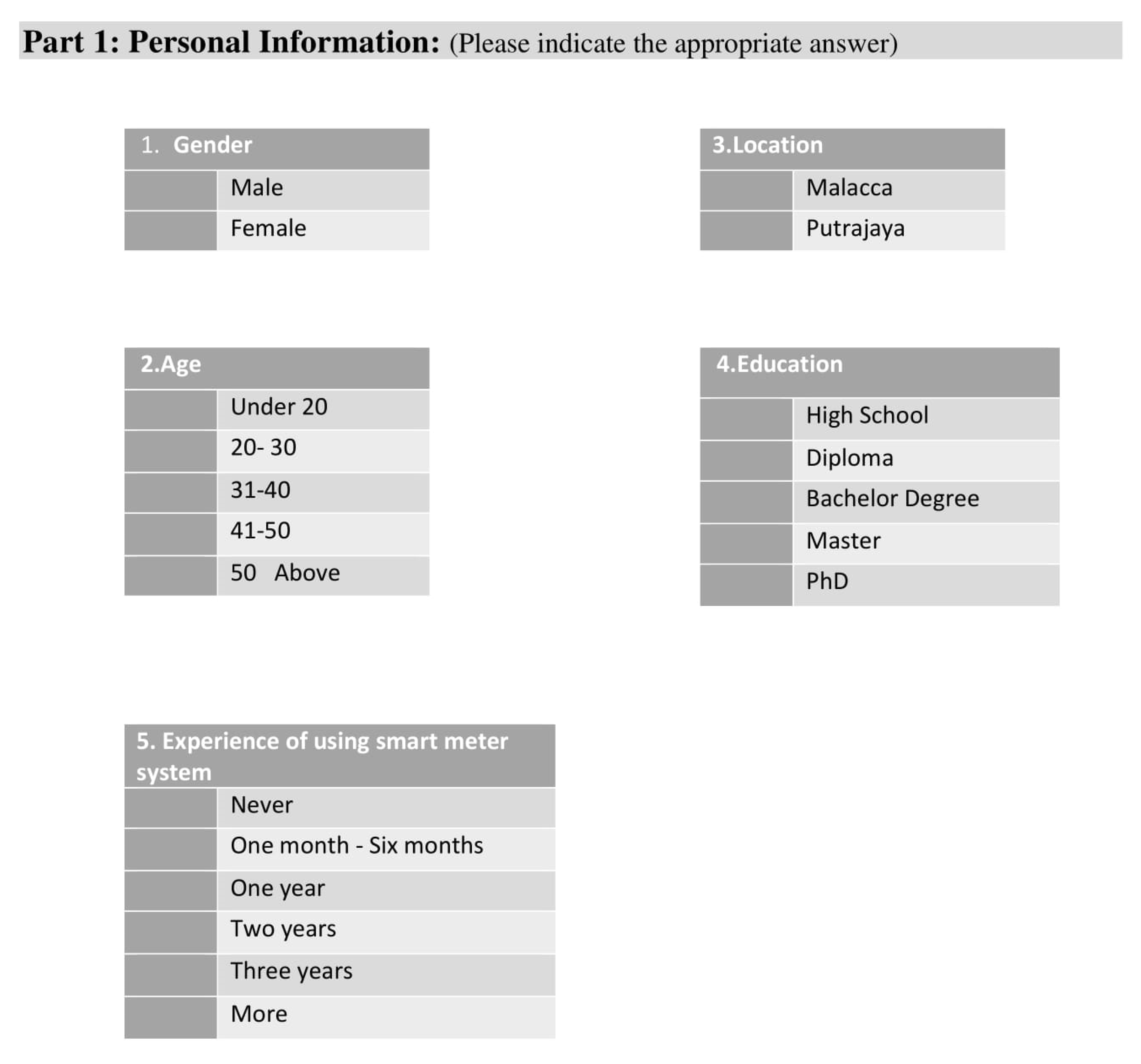


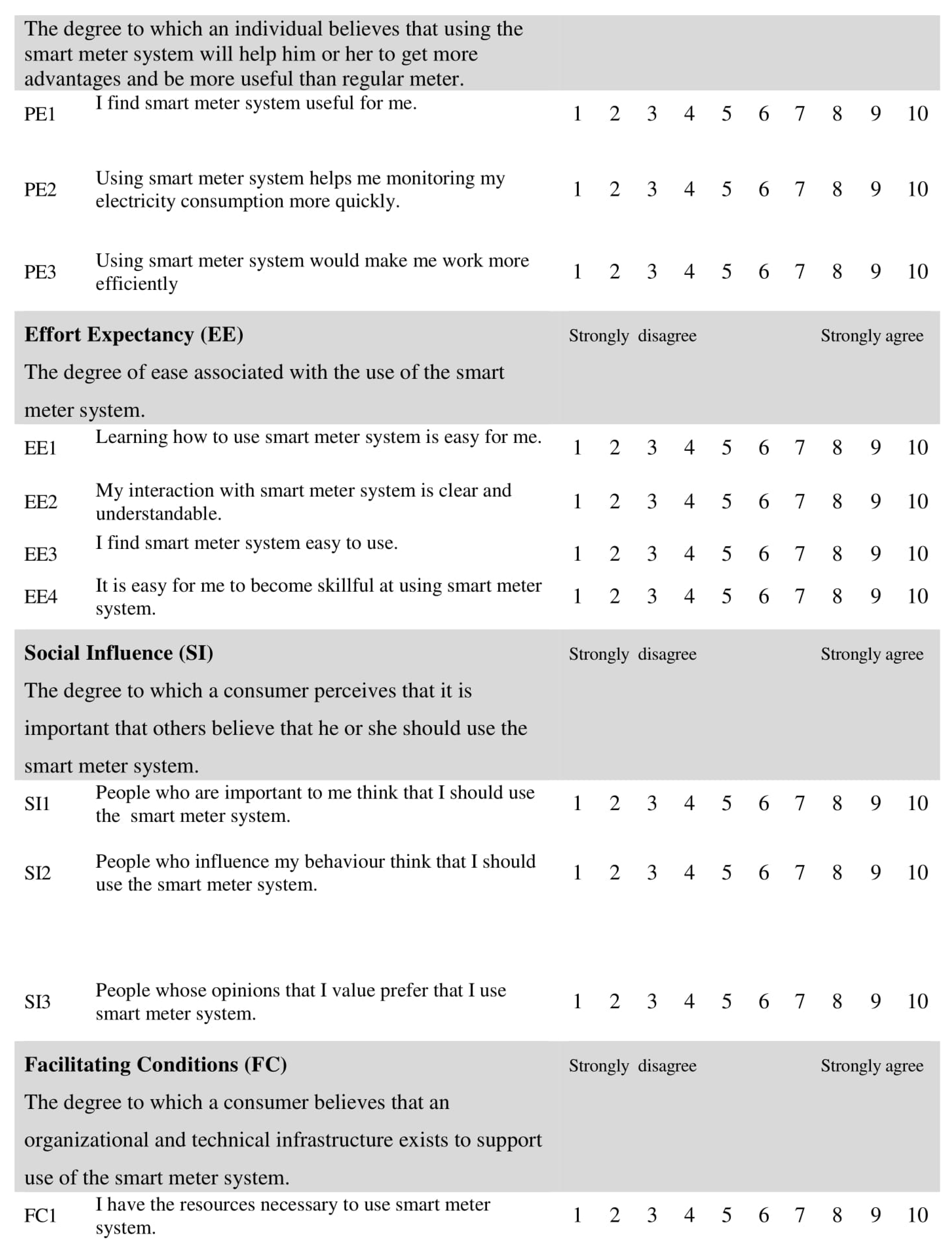
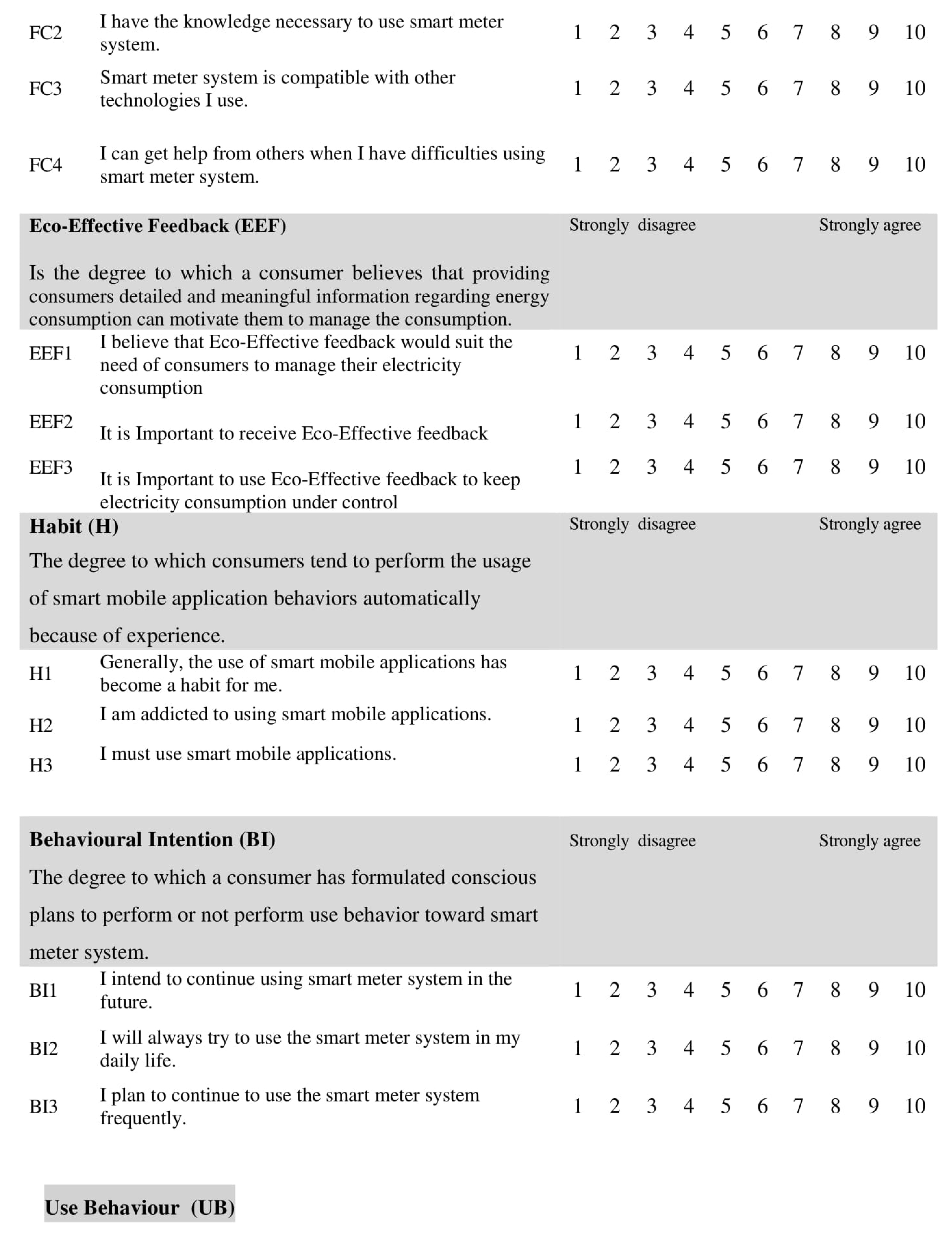

References
- Avancini, D.B.; Rodrigues, J.J.P.C.; Rabêlo, R.A.L.; Das, A.K.; Kozlov, S.; Solic, P. A new IoT-based smart energy meter for smart grids. Int. J. Energy Res. 2021, 45, 189–202. [Google Scholar] [CrossRef]
- Ahmed, E.; Yaqoob, I.; Gani, A.; Imran, M.; Guizani, M. Internet-of-things-based smart environments: State of the art, taxonomy, and open research challenges. IEEE Wirel. Commun. 2016, 23, 10–16. [Google Scholar] [CrossRef]
- Lloret, J.; Tomas, J.; Canovas, A.; Parra, L. An Integrated IoT architecture for smart metering. IEEE Commun. Mag. 2016, 54, 50–57. [Google Scholar] [CrossRef]
- Hossain, M.S.; Rahman, M.; Sarker, M.T.; Haque, M.E.; Jahid, A. A smart IoT based system for monitoring and controlling the sub-station equipment. Internet Things 2019, 7, 100085. [Google Scholar] [CrossRef]
- Rokan, A.B.; Kotb, Y. Towards a real IoT-based smart meter system. In First International Conference on Sustainable Technologies for Computational Intelligence; Springer: Singapore, 2020. [Google Scholar]
- Priyadharshini, S.; Subramani, C.; Roselyn, J.P. An IOT based smart metering development for energy management system. Int. J. Electr. Comput. Eng. 2019, 9, 3041–3050. [Google Scholar] [CrossRef]
- Gunter, V.J.; Harris, C.K. Noisy Winter: The DDT controversy in the years before silent spring. Rural. Sociol. 1998, 63, 179–198. [Google Scholar] [CrossRef]
- Farhangi, H. A road map to integration: Perspectives on smart grid development. IEEE Power Energy Mag. 2014, 12, 52–66. [Google Scholar] [CrossRef]
- Krishnamurti, T.; Schwartz, D.; Davis, A.; Fischhoff, B.; de Bruin, W.B.; Lave, L.; Wang, J. Preparing for smart grid technologies: A behavioral decision research approach to understanding consumer expectations about smart meters. Energy Policy 2012, 41, 790–797. [Google Scholar] [CrossRef]
- Preeti, S. Why IoT Opportunities Are High, Adoption Rates Low. 2015. Available online: Cxotoday.com (accessed on 14 August 2020).
- Castro, D.; New, J.; McQuinn, A. How Is the Federal Government Using the Internet of Things; Center for Data Innovation: Washington, DC, USA, 2016. [Google Scholar]
- Hoover, M. Study: IoT Adoption Still Slow for Government Agencies. Washington Technology, 26 July 2016. [Google Scholar]
- Alkawsi, G.A.; Ali, N.A.B.; Alghushami, A. Toward understanding individuals’acceptance of internet of things-based services: Developing an instrument to measure the acceptance of smart meters. J. Theor. Appl. Inf. Technol. 2018, 96, 4265–4281. [Google Scholar]
- Alkawsi, G.A.; Ali, N.A.B. A systematic review of individuals’ acceptance of IOT-based technologies. Int. J. Eng. Technol. (UAE) 2018, 7, 136–142. [Google Scholar] [CrossRef]
- Wolsink, M. The research agenda on social acceptance of distributed generation in smart grids: Renewable as common pool resources. Renew. Sustain. Energy Rev. 2012, 16, 822–835. [Google Scholar] [CrossRef]
- Alkawsi, G.A.; Ali, N.; Mustafa, A.S.; Baashar, Y.; Alhussian, H.; Alkahtani, A.; Tiong, S.K.; Ekanayake, J. A hybrid SEM-neural network method for identifying acceptance factors of the smart meters in Malaysia: Challenges perspective. Alex. Eng. J. 2021, 60, 227–240. [Google Scholar] [CrossRef]
- Alkawsi, G.A.; Baashar, Y. An empirical study of the acceptance of IoT-based smart meter in Malaysia: The effect of electricity-saving knowledge and environmental awareness. IEEE Access 2020, 8, 42794–42804. [Google Scholar] [CrossRef]
- Venkatesh, V.; Thong, J.Y.L.; Xu, X. Consumer acceptance and use of information technology: Extending the unified theory of acceptance and use of technology. MIS Q. 2012, 36, 157–178. [Google Scholar] [CrossRef] [Green Version]
- Koivumäki, T.; Ristola, A.; Kesti, M. The effects of information quality of mobile information services on user satisfaction and service acceptance–empirical evidence from Finland. Behav. Inf. Technol. 2008, 27, 375–385. [Google Scholar] [CrossRef]
- Xu, H.; Gupta, S. The effects of privacy concerns and personal innovativeness on potential and experienced customers’ adoption of location-based services. Electron. Mark. 2009, 19, 137–149. [Google Scholar] [CrossRef]
- Venkatesh, V.; Morris, M.G.; Davis, G.B.; Davis, F.D. User acceptance of information technology: Toward a unified view. MIS Q. 2003, 27, 425–478. [Google Scholar] [CrossRef] [Green Version]
- Raman, A.; Don, Y. Preservice teachers’ acceptance of learning management software: An application of the UTAUT2 model. Int. Educ. Stud. 2013, 6, 157–164. [Google Scholar] [CrossRef] [Green Version]
- Slade, L.E.; Williams, M.D.; Dwivedi, Y. Extending UTAUT2 to explore consumer adoption of mobile payments. In Proceedings of the 23rd UK Academy for Information Systems Conference (UKAIS), Milan, Italy, 15–18 December 2013; p. 36. [Google Scholar]
- Arenas-Gaitán, J.; Peral-Peral, B.; Ramón-Jerónimo, M.A. Elderly and internet banking: An application of UTAUT2. J. Internet Bank. Commer. 2015, 20, 1–23. [Google Scholar]
- Alalwan, A.A.; Dwivedi, Y.K.; Rana, N.P. Factors influencing adoption of mobile banking by Jordanian bank customers: Extending UTAUT2 with trust. Int. J. Inf. Manag. 2017, 37, 99–110. [Google Scholar] [CrossRef]
- Alalwan, A.A.; Dwivedi, Y.K.; Rana, N.P.; Algharabat, R. Examining factors influencing Jordanian customers’ intentions and adoption of internet banking: Extending UTAUT2 with risk. J. Retail. Consum. Serv. 2018, 40, 125–138. [Google Scholar] [CrossRef] [Green Version]
- El-Masri, M.; Tarhini, A. Factors affecting the adoption of e-learning systems in Qatar and USA: Extending the Unified Theory of Acceptance and Use of Technology 2 (UTAUT2). Educ. Technol. Res. Dev. 2017, 65, 743–763. [Google Scholar] [CrossRef]
- Crespo, A.H.; San Martín Gutiérrez, H.; de los Salmones, M.D.G. Explaining the adoption of social networks sites for sharing user-generated content: A revision of the UTAUT2. Comput. Hum. Behav. 2017, 71, 209–217. [Google Scholar] [CrossRef] [Green Version]
- Oliveira, T.; Thomas, M.; Baptista, G.; Campos, F. Mobile payment: Understanding the determinants of customer adoption and intention to recommend the technology. Comput. Hum. Behav. 2016, 61, 404–414. [Google Scholar] [CrossRef]
- Gupta, A.; Dogra, N.; George, B. What determines tourist adoption of smartphone apps? J. Hosp. Tour. Technol. 2018, 9, 50–64. [Google Scholar] [CrossRef]
- Chopdar, P.K.; Korfiatis, N.; Sivakumar, V.; Lytras, M.D. Mobile shopping apps adoption and perceived risks: A cross-country perspective utilizing the Unified Theory of Acceptance and Use of Technology. Comput. Hum. Behav. 2018, 86, 109–128. [Google Scholar] [CrossRef] [Green Version]
- Indrawati; Tohir, L.M. Predicting smart metering acceptance by residential consumers: An Indonesian perspective. In Proceedings of the 2016 4th International Conference on Information and Communication Technology (ICoICT), Bandung, Indonesia, 25–27 May 2016; pp. 1–6. [Google Scholar]
- Lee, Y.; Kozar, K.A.; Larsen, K.R. The technology acceptance model: Past, present, and future. Commun. Assoc. Inf. Syst. 2003, 12, 50. [Google Scholar] [CrossRef]
- Momani, A.M.; Jamous, M. The evolution of technology acceptance theories. Int. J. Contemp. Comput. Res. 2017, 1, 51–58. [Google Scholar]
- Sun, H.; Zhang, P. The role of moderating factors in user technology acceptance. Int. J. Human Comput. Stud. 2006, 64, 53–78. [Google Scholar] [CrossRef] [Green Version]
- Bagozzi, R.P. The legacy of the technology acceptance model and a proposal for a paradigm shift. J. Assoc. Inf. Syst. 2007, 8, 3. [Google Scholar] [CrossRef]
- Van Raaij, E.M.; Schepers, J.J. The acceptance and use of a virtual learning environment in China. Comput. Educ. 2008, 50, 838–852. [Google Scholar] [CrossRef]
- Dwivedi, Y.K.; Rana, N.P.; Jeyaraj, A.; Clement, M.; Williams, M.D. Re-examining the unified theory of acceptance and use of technology (UTAUT): Towards a revised theoretical model. Inf. Syst. Front. 2019, 21, 719–734. [Google Scholar] [CrossRef] [Green Version]
- Chong, A.Y.-L. Predicting m-commerce adoption determinants: A neural network approach. Expert Syst. Appl. 2013, 40, 523–530. [Google Scholar] [CrossRef]
- Carter, L.; Schaupp, L.C. Efficacy and acceptance in e-file adoption. In Proceedings of the 14th Americas Conference on Information Systems (AMCIS 2008), Toronto, ON, Canada, 14–17 August 2008; p. 320. [Google Scholar]
- Kranz, L.; Gallenkamp, J.; Picot, A.O. Exploring the role of control–smart meter acceptance of residential consumers. In Proceedings of the 16th Americas Conference on Information Systems (AMCIS 2010), Lima, Peru, 12–15 August 2010; p. 315. [Google Scholar]
- Hurst, W.; Tekinerdogan, B.; Kotze, B. Perceptions on smart gas meters in smart cities for reducing the carbon footprint. Smart Cities 2020, 3, 58. [Google Scholar] [CrossRef]
- Wunderlich, P.; Veit, D.; Sarker, S. Examination of the determinants of smart meter adoption: An user perspective. In Proceedings of the 33rd International Conference on Information Systems (ICIS 2012), Orlando, FL, USA, 16–19 December 2012. [Google Scholar]
- Mah, D.N.-Y.; Van Der Vleuten, J.M.; Ip, J.C.-M.; Hills, P.R. Governing the transition of socio-technical systems: A case study of the development of smart grids in Korea. Energy Policy 2012, 45, 133–141. [Google Scholar] [CrossRef] [Green Version]
- Chen, K.-Y.; Yeh, C.-F. Factors affecting adoption of smart meters in the post-Fukushima era in Taiwan: An extended protection motivation theory perspective. Behav. Inf. Technol. 2017, 36, 955–969. [Google Scholar] [CrossRef]
- Kranz, L.; Gallenkamp, J.; Picot, A. Power control to the people? Private consumers’ acceptance of smart meters. In Proceedings of the 18th European Conference on Information Systems (ECIS 2010), Pretoria, South Africa, 7–9 June 2010. [Google Scholar]
- Karlin, B. Public acceptance of smart meters: Integrating psychology and practice. In Proceedings of the ACEEE Summer Study on Energy Efficiency in Buildings, Pacific Grove, CA, USA, 12–17 August 2012. [Google Scholar]
- Fredericks, D.; Fan, Z.; Woolley, S.; De Quincey, E.; Streeton, M. A decade on, how has the visibility of energy changed? Energy feedback perceptions from UK focus groups. Energies 2020, 13, 2566. [Google Scholar] [CrossRef]
- Vassileva, I.; Campillo, J. Consumers’ perspective on full-scale adoption of smart meters: A case study in Vasteras, Sweden. Resources 2016, 5, 3. [Google Scholar] [CrossRef] [Green Version]
- Chen, C.-F.; Xu, X.; Arpan, L. Between the technology acceptance model and sustainable energy technology acceptance model: Investigating smart meter acceptance in the United States. Energy Res. Soc. Sci. 2017, 25, 93–104. [Google Scholar] [CrossRef]
- Raimi, K.T.; Carrico, A.R. Understanding and beliefs about smart energy technology. Energy Res. Soc. Sci. 2016, 12, 68–74. [Google Scholar] [CrossRef]
- Zhou, S.; Brown, M.A. Smart meter deployment in Europe: A comparative case study on the impacts of national policy schemes. J. Clean. Prod. 2017, 144, 22–32. [Google Scholar] [CrossRef]
- Toft, M.B.; Schuitema, G.; Thøgersen, J. Responsible technology acceptance: Model development and application to con-sumer acceptance of Smart Grid technology. Appl. Energy 2014, 134, 392–400. [Google Scholar] [CrossRef]
- Yang, H.; Lee, H.; Zo, H. User acceptance of smart home services: An extension of the theory of planned behavior. Ind. Manag. Data Syst. 2017, 117, 68–89. [Google Scholar] [CrossRef]
- Gerpott, T.J.; Paukert, M. Determinants of willingness to pay for smart meters: An empirical analysis of household customers in Germany. Energy Policy 2013, 61, 483–495. [Google Scholar] [CrossRef]
- Bugden, D.; Stedman, R. A synthetic view of acceptance and engagement with smart meters in the United States. Energy Res. Soc. Sci. 2019, 47, 137–145. [Google Scholar] [CrossRef]
- Shuhaiber, A. The role of perceived control, enjoyment, cost, sustainability and trust on intention to use smart meters: An empirical study using SEM-PLS. In World Conference on Information Systems and Technologies; Springer: Cham, Switzerland, 2018. [Google Scholar]
- Buchanan, K.; Banks, N.; Preston, I.; Russo, R. The British public’s perception of the UK smart metering initiative: Threats and opportunities. Energy Policy 2016, 91, 87–97. [Google Scholar] [CrossRef] [Green Version]
- Park, C.-K.; Kim, H.-J.; Kim, Y.-S. A study of factors enhancing smart grid consumer engagement. Energy Policy 2014, 72, 211–218. [Google Scholar] [CrossRef]
- Frye, N.E.; Dornisch, M.M. When is trust not enough? The role of perceived privacy of communication tools in comfort with self-disclosure. Comput. Hum. Behav. 2010, 26, 1120–1127. [Google Scholar] [CrossRef]
- Notani, A.S. Moderators of perceived behavioral control’s predictiveness in the theory of planned behavior: A meta-analysis. Consum. Psychol. Rev. 1998, 7, 247–271. [Google Scholar] [CrossRef]
- Limayem, M.; Hirt, S.G.; Cheung, C.M.K. How habit limits the predictive power of intention: The case of information systems continuance. MIS Q. 2007, 31, 705–737. [Google Scholar] [CrossRef] [Green Version]
- Murray, K.B.; Häubl, G. Explaining cognitive lock-in: The role of skill-based habits of use in consumer choice. J. Consum. Res. 2007, 34, 77–88. [Google Scholar] [CrossRef]
- Baptista, G.; Oliveira, T. Understanding mobile banking: The unified theory of acceptance and use of technology combined with cultural moderators. Comput. Hum. Behav. 2015, 50, 418–430. [Google Scholar] [CrossRef]
- Jasperson, S.J.; Carter, P.E.; Zmud, R.W. A comprehensive conceptualization of post-adoptive behaviors associated with information technology enabled work systems. MIS Q. 2005, 29, 525–557. [Google Scholar] [CrossRef]
- Sultan, F. Consumer response to the Internet: An exploratory tracking study of on-line home users. J. Bus. Res. 2002, 55, 655–663. [Google Scholar] [CrossRef]
- Liébana-Cabanillas, F.; Sánchez-Fernández, J.; Muñoz-Leiva, F. The moderating effect of experience in the adoption of mobile payment tools in virtual social networks: The m-payment acceptance model in virtual social networks (MPAM-VSN). Int. J. Inf. Manag. 2014, 34, 151–166. [Google Scholar] [CrossRef]
- Yi, Y.; Wu, Z.; Tung, L.L. How individual differences influence technology usage behavior? Toward an integrated framework. J. Comput. Inf. Syst. 2005, 46, 52–63. [Google Scholar]
- Agarwal, R.; Prasad, J. A conceptual and operational definition of personal innovativeness in the domain of information technology. Inf. Syst. Res. 1998, 9, 204–215. [Google Scholar] [CrossRef]
- Dabholkar, P.A.; Bagozzi, R.P. An attitudinal model of technology-based self-service: Moderating effects of consumer traits and situational factors. J. Acad. Mark. Sci. 2002, 30, 184–201. [Google Scholar] [CrossRef]
- Thiesse, F. RFID, privacy and the perception of risk: A strategic framework. J. Strat. Inf. Syst. 2007, 16, 214–232. [Google Scholar] [CrossRef]
- Awang, Z.; Afthanorhan, A.; Mamat, M. The Likert scale analysis using parametric based Structural Equation Modeling (SEM). Comput. Methods Soc. Sci. 2016, 4, 13. [Google Scholar]
- Wittink, R.D.; Bayer, L.R. The measurement imperative. Mark. Res. 1994, 6, 14. [Google Scholar]
- Byrne, B.M. Structural Equation Modeling with EQS: Basic Concepts, Applications, and Programming; Routledge: New York, NY, USA, 2013. [Google Scholar]
- Kline, R.B. Principles and Practice of Structural Equation Modeling, 4th ed.; Guilford Publications: New York, NY, USA, 2015. [Google Scholar]
- Shah, R.; Goldstein, S.M. Use of structural equation modeling in operations management research: Looking back and forward. J. Oper. Manag. 2005, 24, 148–169. [Google Scholar] [CrossRef]
- Saunders, N.M.; Lewis, P.; Thornhill, A. Research Methods for Business Students EBook; Pearson Australia Pty Limited: Melbourne, Victoria, Australia, 2015. [Google Scholar]
- Cornford, T.; Smithson, S. Project Research in Information Systems: A Student’s Guide; Macmillan International Higher Education: London, UK, 2005. [Google Scholar]
- Hair, J.F.; Ringle, C.M.; Sarstedt, M. PLS-SEM: Indeed a silver bullet. J. Mark. Theory Pract. 2011, 19, 139–152. [Google Scholar] [CrossRef]
- Chin, W.W. The partial least squares approach to structural equation modeling. Mod. Methods Bus. Res. 1998, 295, 295–336. [Google Scholar]
- Yu, J.; Cooper, H. A quantitative review of research design effects on response rates to questionnaires. J. Mark. Res. 1983, 20, 36–44. [Google Scholar] [CrossRef]
- Hulland, J. Use of partial least squares (PLS) in strategic management research: A review of four recent studies. Strateg. Manag. 1999, 20, 195–204. [Google Scholar] [CrossRef]
- Fornell, C.; Larcker, D.F. Evaluating structural equation models with unobservable variables and measurement error. J. Mark. Res. 1981, 18, 39–50. [Google Scholar] [CrossRef]
- Cohen, J. Statistical Power Analysis for the Behavioral Sciences; Academic Press: Cambridge, MA, USA, 2013. [Google Scholar]
- Chopra, S.; Rajan, P. Modeling intermediary satisfaction with mandatory adoption of e-government technologies for food distribution. Inf. Technol. Int. Dev. 2016, 12, 15. [Google Scholar]
- Wamatu, A.K. Moderating Factors in Adoption of Mobile Financial Services in Kenya. Ph.D. Thesis, University of Nairobi, Nairobi, Kenya, 2013. [Google Scholar]
- Rogers, E.M. Diffusion of Innovations; Simon and Schuster: New York, NY, USA, 2010. [Google Scholar]
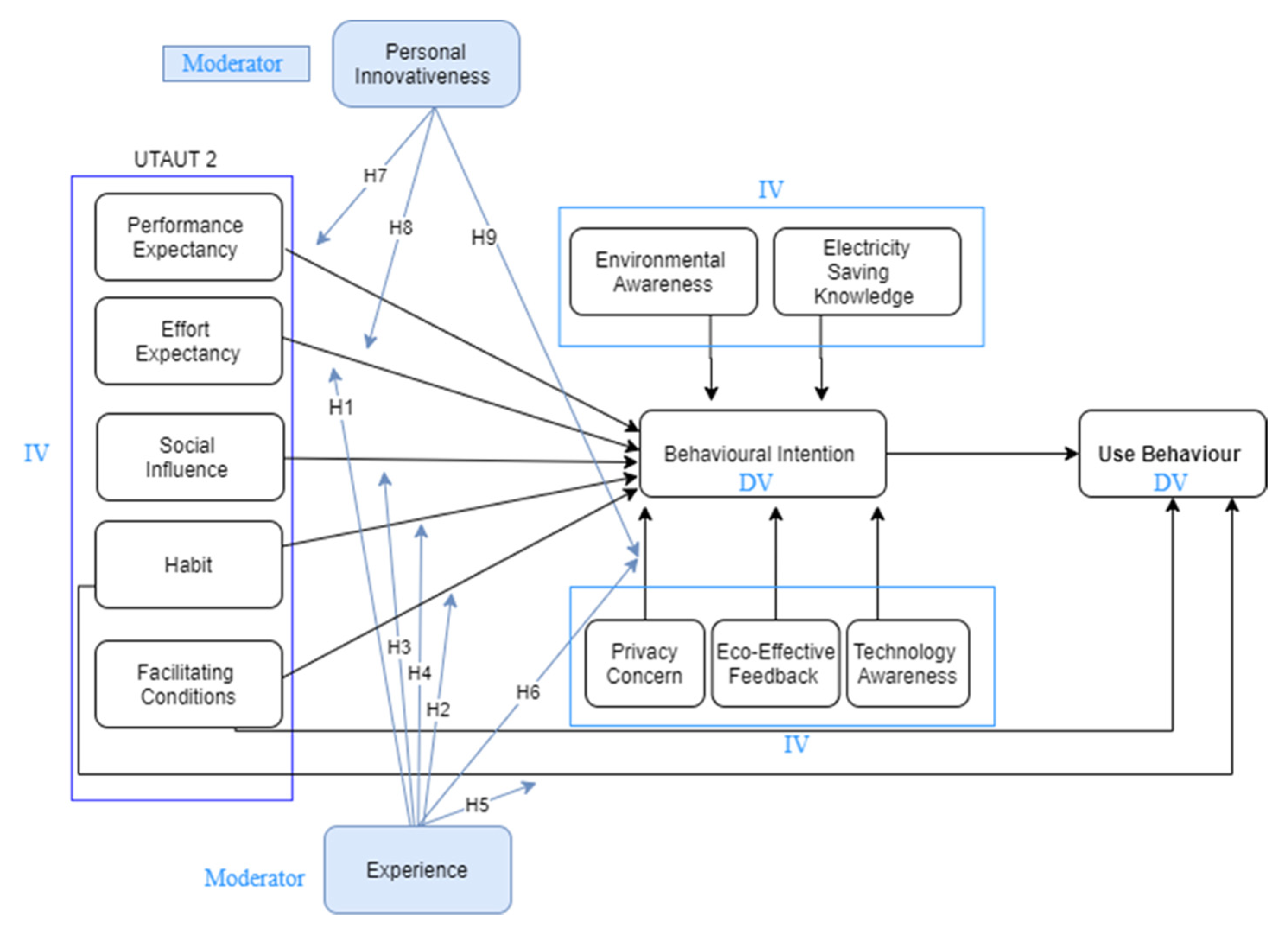
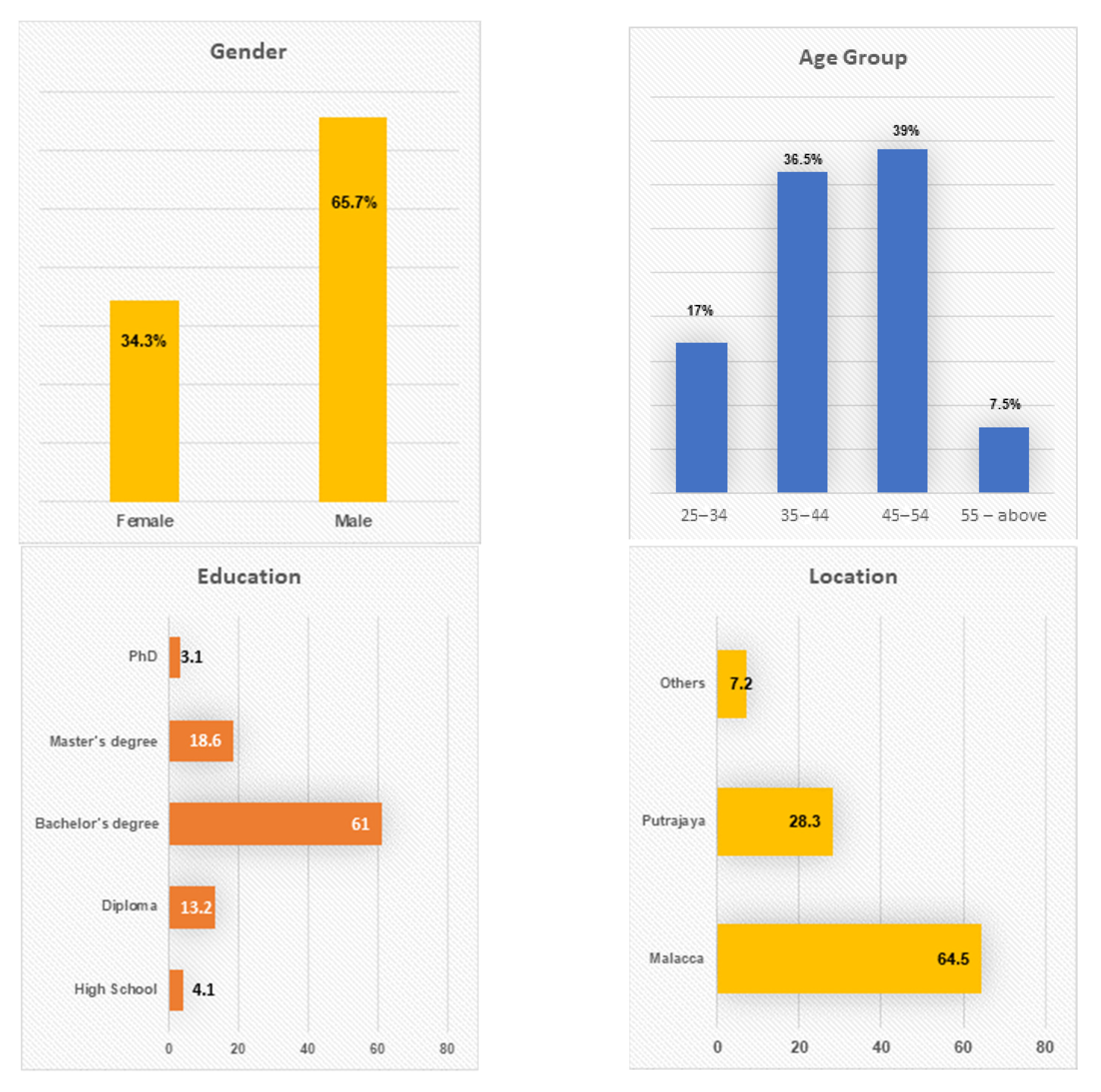




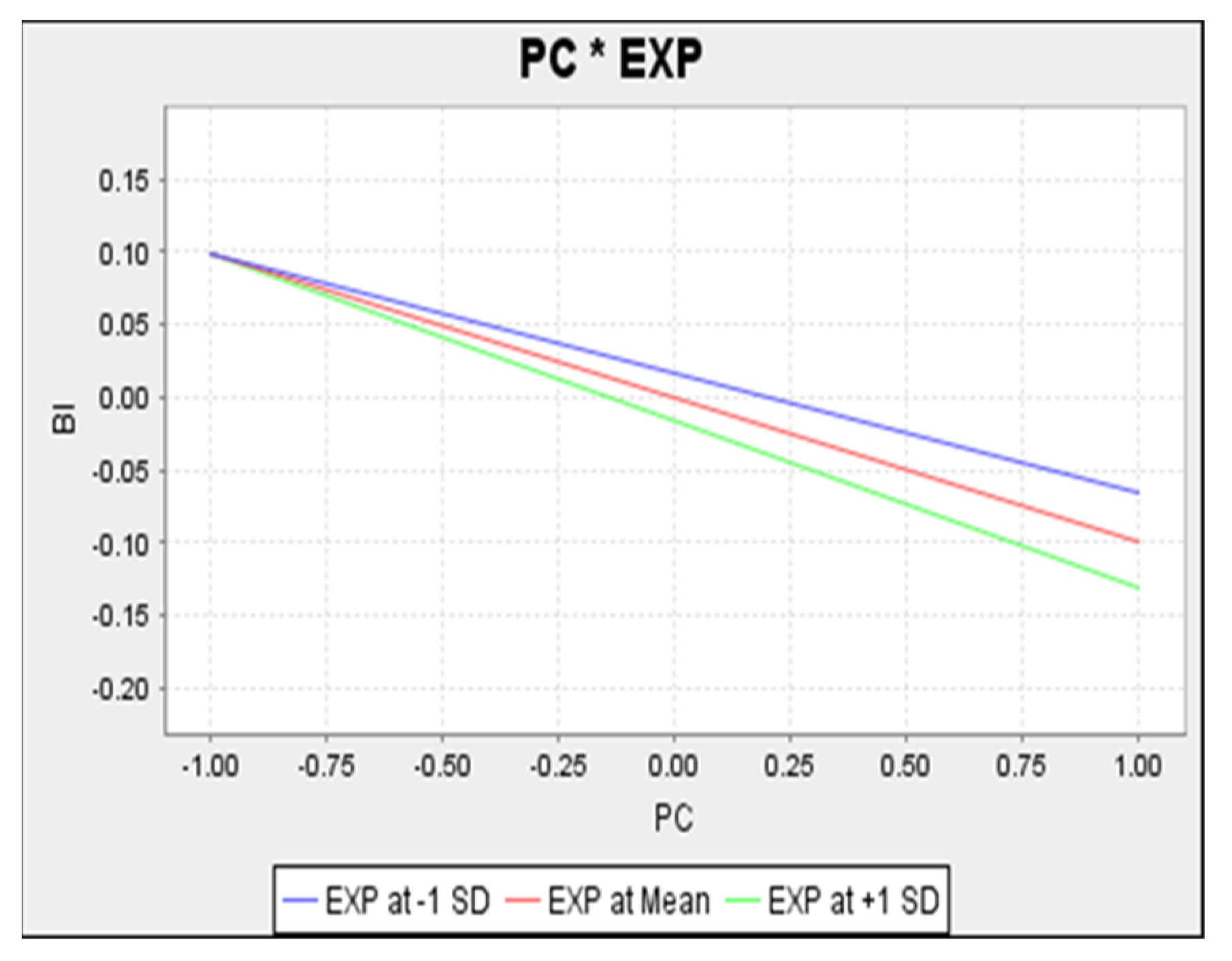
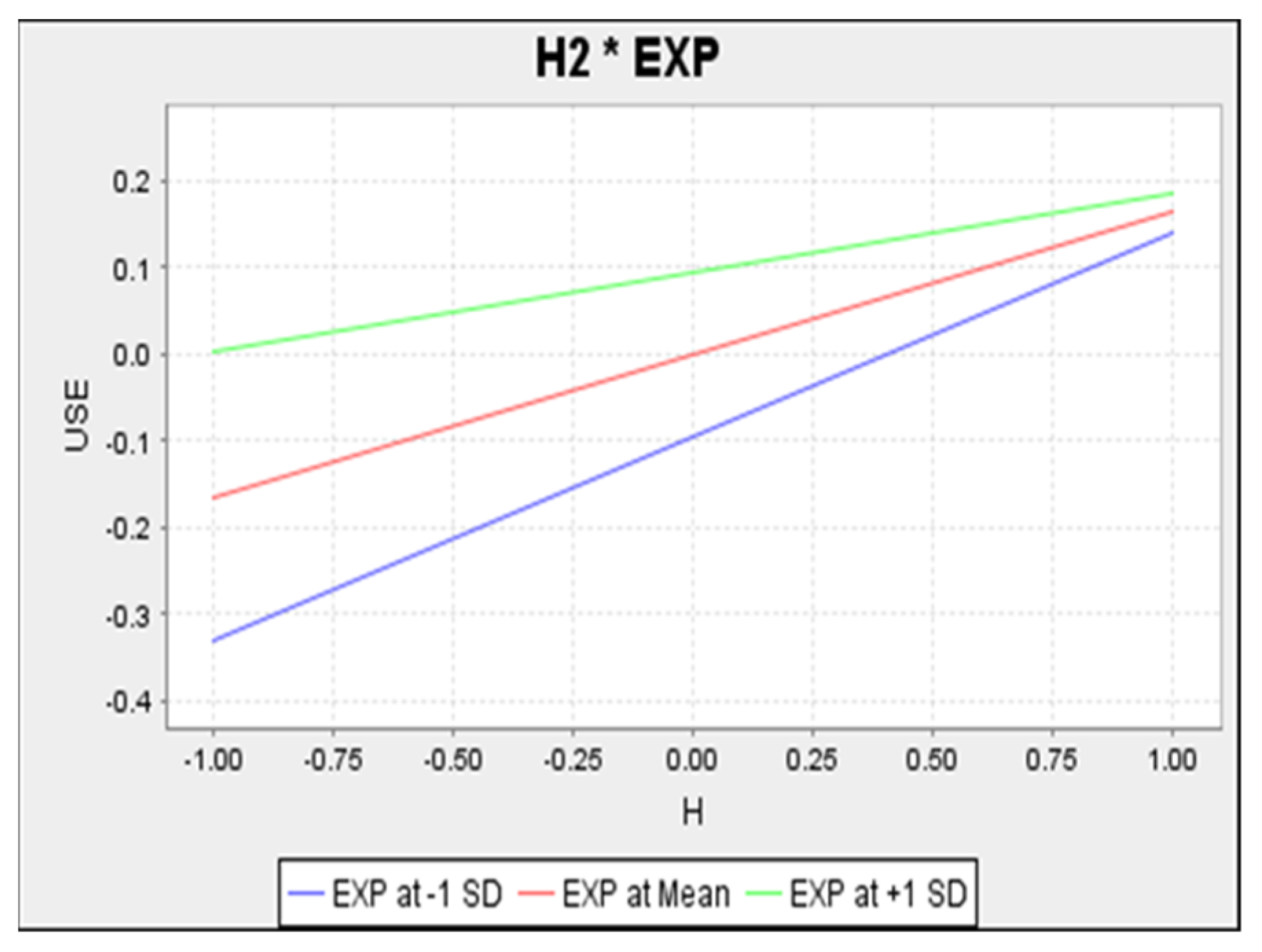
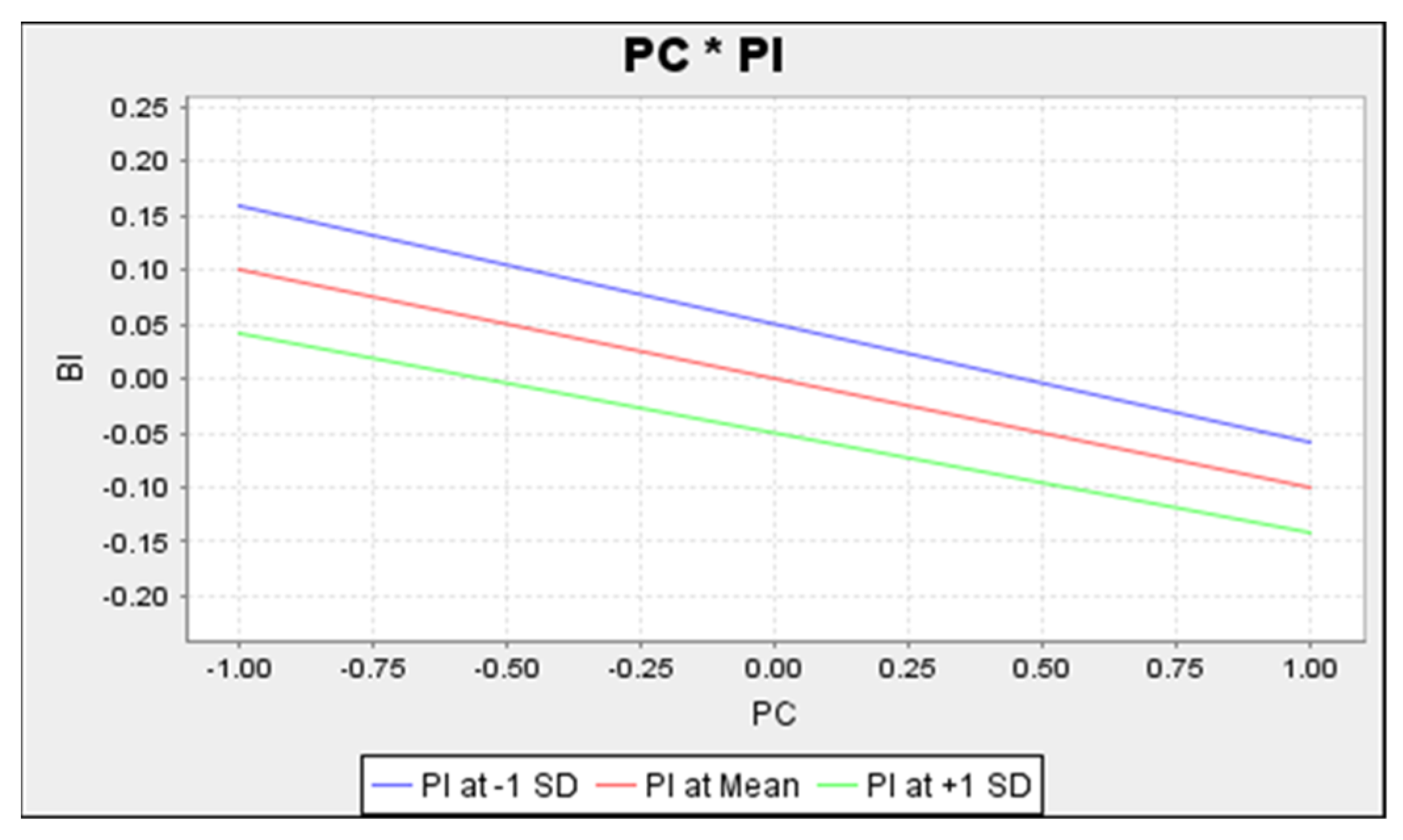
| Author(s) | Field of Study | Respondents | Modification of Constructs | R2 |
|---|---|---|---|---|
| Arenas et al. [24] | Internet banking | Elderly | None | 62.3% |
| Alalwan et al. [25] | Mobile banking | Bank Customers | Trust | 65% |
| Alalwan et al. [26] | Internet banking | Bank Customers | Perceived risk | 64% |
| El-Masri & Tarhini [27] | E-learning systems | University Students | Trust | 68% |
| Herrero & Martín [28] | Social network sites | Tourism industry | Substitute price value with privacy concern | 77% |
| Oliveira et al. [29] | Mobile payment | Mobile customers in Portugal | Perceived security and intention to recommend. | 61.3% |
| Gupta et al. [30] | Travel apps | Tourist | - | 58.1% |
| Chopdar et al. [31] | Mobile shopping | Consumers in USA and India | Perceived Risk was added | 64% |
| Tohir [32] | Smart meters acceptance | Consumers in Indonesia | Perceived Security and Risk | 63% |
| Study | Targeted Case | Observed Behaviour | Model | Method | Location | Findings | Limitations |
|---|---|---|---|---|---|---|---|
| [50] | Householders who have not installed smart meters | Smart meter support and adoption intention | TAM, SETA | Online-based survey | USA | Privacy, usefulness, and problem perception affect support. Privacy, usefulness, and problem perception affect intention. Problem perception affects Usefulness. | The participants were volunteers. As a predictor of the outcome variables, only electricity curtailment behaviors were used. The effect of certain primary TAM variables has not been investigated. |
| [46] | Customers with smart meter awareness | Intention to use | TAM | Online-based survey | Germany | Perceived ease of use, perceived usefulness, and subjective control affect attitude. Attitude affects intention to use. | Potential antecedents (e.g., social influence, self-efficacy) of the outstanding values integrated in the proposed model that could provide more insights were not included. |
| [51] | Online users | Likelihood of adoption | General Concepts | Online-based survey | USA | Global warming, privacy, security, health, and affordability affect the likelihood of adoption | The effect of some primary variables in adoption and acceptance models, such as ease of use and usefulness, was not investigated. |
| [52] | Electricity consumers in five EU countries | Penetration rate | General Concepts | Comparative case study | Sweden, Finland, Denmark, Germany, Netherlands | Countries with a policy composition that introduces various hurdles to smart meters tend to be pioneers, while laggards frequently ignore or refuse to adopt policies. | Most of the countries studied were all relatively small markets with active smart meter policies & penetration, so it is not possible to generalize them. |
| [53] | Electricity consumers | Acceptance | TAM, NAM | Online-based survey | Danish, Norwegian, Swiss | Perceived ease of use and perceived usefulness affect attitude and personal norm. Attitude and personal norm affect acceptance. | The social norm was not investigated as a main variable in the TAM. Only the variables used in the model were examined, and all external factors were omitted. |
| [54] | Customers who had not used smart home services | Behavioural intentions | TPB | Online-based survey | Korea | Mobility, security/privacy risk, & trust in service provider are affecting the adoption of smart home services. | The individual variations of the survey participants in this sample were not investigated. |
| [47] | Secondary data | Public acceptance | DPT | Review | USA | The study is more on deployment strategies, but it highlighted the importance of technology awareness and effective feedback on accepting the smart meter. | The findings do not provide sufficient information about factors influencing the public to accept the smart meter. |
| [55] | Residential customers of power suppliers | Willingness to pay | General Concepts | Online-based survey | Germany | Expected savings, intention to change usage behaviours, usefulness of consumption feedback, trust in data protection, environmental awareness affect willingness to pay. | Instead of capturing individual payment behaviors that are strongly and positively linked, the study relies on specified maximum levels for different SM price components. |
| [45] | Residents | Intention to adopt | PMT | A paper-based survey | Taiwan | Perceived severity, perceived, vulnerability, response cost, response efficacy, self-efficacy, secondary data influence, social influence affects the intention to adopt. | Did not examined use behaviour. |
| [56] | Expected users of smart meter | Acceptance & Behavioural Intention | General Concepts | Mail survey | USA | Climate change risk & familiarity of smart meters have strongest effect on acceptance, Age & income have strongest effect on engagement. | Did include technical-based factors such as usefulness, ease of use, and feedback. |
| [57] | Residents with smart meter awareness | Behavioural Intention | General Concepts | Online-based survey | Jordan | Residents’ intentions to use smart meters are influenced by perceived control, perceived enjoyment, sustainability & trust. | Did not include sufficient variables which can reflect user’s perception from technology context. |
| [58] | Householders & SMEs | Perception | General Concepts | Focus group | UK | The opportunities and threats of smart metering initiatives from the consumers perspective. | As the methodology was a focus group, the findings obtained could only reflect the groups which were sampled. |
| [59] | Electricity consumers | Intention to use | TAM, PRT | Interview | Korea | Perceived usefulness, perceived ease of use & perceived risk are significant factors. | The impact of some main variables in TAM, e.g., social norm, was not investigated. |
| Current study | Electricity consumers/Households with smart meters installed | Intention to use & actual use behavior | UTAUT2 | Paper & Online-based survey | Malaysia | Confirmed users experience of smart meter is moderating the relations between IVs & DVs in UTAUT2 model. Personal Innovativeness only moderate relationship between privacy concerns & behavioural intention. | Did not evaluate other moderators such as age, gender, and income. |
| Construct | Composite Reliability (CR) | Average Variance Extracted (AVE) |
|---|---|---|
| Performance expectancy | 0.982 | 0.947 |
| Effort expectancy | 0.985 | 0.942 |
| Environmental awareness | 0.985 | 0.943 |
| Facilitating conditions | 0.978 | 0.918 |
| Habit | 0.979 | 0.938 |
| Eco-effective feedback | 0.981 | 0.945 |
| Privacy concerns | 0.985 | 0.942 |
| Social influence | 0.975 | 0.93 |
| Technology awareness | 0.963 | 0.837 |
| Electricity saving knowledge | 0.988 | 0.943 |
| Behavioral intention | 0.981 | 0.945 |
| Use behaviour | 0.988 | 0.977 |
| BI | EEF | EE | ESK | EA | FC | H | PE | PC | SI | TA | UB | |
|---|---|---|---|---|---|---|---|---|---|---|---|---|
| BI | 0.972 | |||||||||||
| EEF | 0.903 | 0.972 | ||||||||||
| EE | 0.924 | 0.851 | 0.971 | |||||||||
| ESK | 0.909 | 0.827 | 0.854 | 0.983 | ||||||||
| EA | 0.816 | 0.74 | 0.814 | 0.742 | 0.971 | |||||||
| FC | 0.9 | 0.86 | 0.838 | 0.819 | 0.768 | 0.958 | ||||||
| H | 0.828 | 0.836 | 0.789 | 0.764 | 0.681 | 0.766 | 0.969 | |||||
| PE | 0.916 | 0.848 | 0.863 | 0.837 | 0.77 | 0.831 | 0.747 | 0.973 | ||||
| PC | −0.557 | −0.431 | −0.527 | −0.492 | −0.469 | −0.452 | −0.337 | −0.461 | 0.97 | |||
| SI | 0.753 | 0.769 | 0.724 | 0.666 | 0.643 | 0.748 | 0.755 | 0.741 | −0.201 | 0.964 | ||
| TA | 0.68 | 0.623 | 0.636 | 0.608 | 0.464 | 0.646 | 0.64 | 0.64 | −0.204 | 0.696 | 0.915 | |
| UB | 0.529 | 0.508 | 0.518 | 0.5 | 0.434 | 0.441 | 0.492 | 0.468 | −0.245 | 0.409 | 0.395 | 0.988 |
| Hypothesis | Beta Coefficient (β) | T-Value | p-Value | Result | |
|---|---|---|---|---|---|
| H1 | Experience × Effort Expectancy → Behavioural Intention | −0.027 | 2.908 | 0.003 | Supported |
| H2 | Experience × Facilitating Conditions → Behavioural Intention | −0.011 | 1.408 | 0.189 | Not-Supported |
| H4 | Experience × Habit → Behavioural Intention | 0.019 | 2.977 | 0.006 | Supported |
| H5 | Experience × Habit → Use Behaviour | −0.072 | 2.367 | 0.011 | Supported |
| H6 | Experience × Privacy concerns → Behavioural Intention | −0.017 | 3.686 | 0.000 | Supported |
| Hypothesis | Beta Coefficient (β) | T-Value | p-Value | Result | |
|---|---|---|---|---|---|
| H7 | PI × Performance Expectancy → Behavioural Intention | 0.005 | 1.190 | 0.152 | Not-supported |
| H8 | PI × Effort Expectancy → Behavioural Intention | −0.004 | 0.885 | 0.298 | Not-supported |
| H9 | PI × Privacy concerns → Behavioural Intention | 0.009 | 3.171 | 0.001 | Supported |
Publisher’s Note: MDPI stays neutral with regard to jurisdictional claims in published maps and institutional affiliations. |
© 2021 by the authors. Licensee MDPI, Basel, Switzerland. This article is an open access article distributed under the terms and conditions of the Creative Commons Attribution (CC BY) license (http://creativecommons.org/licenses/by/4.0/).
Share and Cite
Alkawsi, G.; Ali, N.; Baashar, Y. The Moderating Role of Personal Innovativeness and Users Experience in Accepting the Smart Meter Technology. Appl. Sci. 2021, 11, 3297. https://doi.org/10.3390/app11083297
Alkawsi G, Ali N, Baashar Y. The Moderating Role of Personal Innovativeness and Users Experience in Accepting the Smart Meter Technology. Applied Sciences. 2021; 11(8):3297. https://doi.org/10.3390/app11083297
Chicago/Turabian StyleAlkawsi, Gamal, Nor’ashikin Ali, and Yahia Baashar. 2021. "The Moderating Role of Personal Innovativeness and Users Experience in Accepting the Smart Meter Technology" Applied Sciences 11, no. 8: 3297. https://doi.org/10.3390/app11083297
APA StyleAlkawsi, G., Ali, N., & Baashar, Y. (2021). The Moderating Role of Personal Innovativeness and Users Experience in Accepting the Smart Meter Technology. Applied Sciences, 11(8), 3297. https://doi.org/10.3390/app11083297







